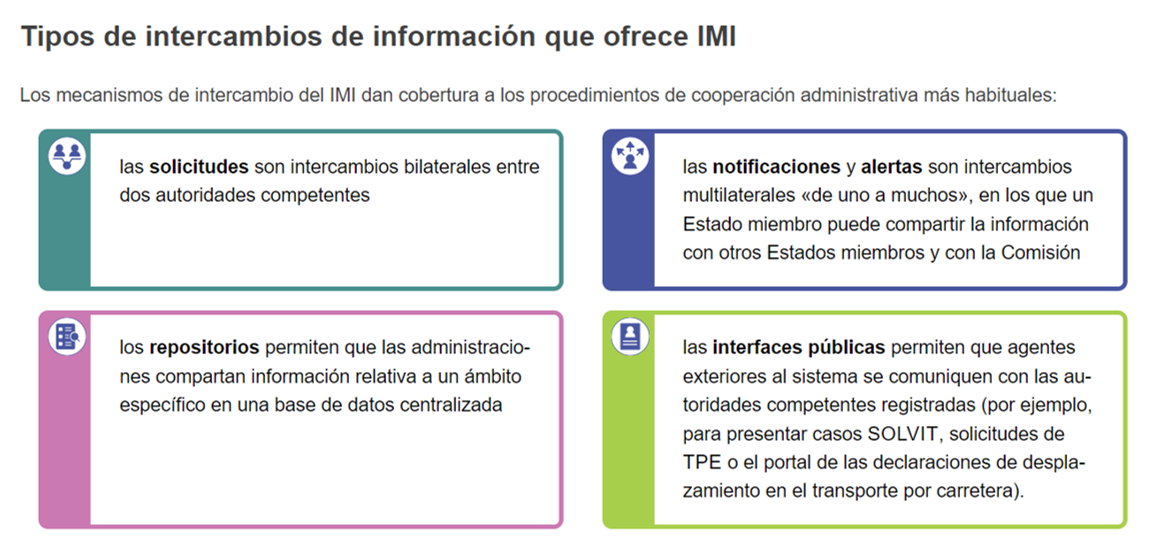Territorial Policy
- Territorial Policy
- Territorial policy (auntonomous communities)
- Autonomy statutes
- Legal regime
- Transfers
- Transfer royal decrees
- Operating rules of the Joint Committees of transfers
- General information and statistics of transfers: Transfer approved (1978-2023) and full of joint commissions of transfers by State legislatures
- Basic data on transfers in the XV state legislature
- Basic data on transfers in the XIV state legislature
- Basic data on transfers in the XIII state legislature
- Basic data on transfers in the XII state legislature
- Basic data on transfers in the XI state legislature
- Basic data on transfers in the state legislature X
- Basic data on transfers in the ninth state legislature
- Basic data on transfers in region VIII state legislature
Legislative areas in IMI
In a single system IMI addresses the needs of cooperation from various fields of legislation relating to the internal market of the HAT.
The IMI was launched in February 2008 as support for the directive of recognition of professional qualifications, and since December 2009 applies to the exchange of information in accordance with the provisions in chapter VI of D. of services.
Subsequently, the system has been modified to do so easily adaptable to other areas and has adopted a regulation HAT on IMI which provides a solid legal basis for its expansion into new Areas. As a result of these efforts, the system applies to a growing number of areas listed below, in continuous evolution.

The needs of administrative cooperation established in each area are resolved customizing generalist modules for cooperation. As Well there is a module of consultations (which allows two authorities exchange questions / answers and documents on the basis of predefined questionnaire specific to each Area). There is another module to manage alerts, in which a risk requires spread the news of risk and its causes, as well as establish a channel to share information until the galvanisation risk. That same module (which allows communication initiated by an authority but just several participating) is also used to create notifications of various types (such as national comunicarnormas obligations that make use of the exceptions in European standards). Exists for the areas that require the possibility of creating repositories of data and documents (e.g. can serun begynne container licences issued since the EEMM in a certain field).
Each of the legislative fields incorporated into IMI can make use of one or more modules. Thus, e.g., enjuliode 2012 the system served Directive 2005 / 36 / EC of professional qualifications with a single flow that allows information exchanges predefined through questionnaires and Directive 2006 / 123 / EC of services that besides a flow requests for information there is another for communication of alerts. Subsequently have been added other Legislative fields and the use of other modules on these two cited as an example.
Each authority (and inside each of its users) can be defined permissions complete or only on part of the directives and possible modules in the system.
Currently Future attended
- Directives of recognition of professional qualifications (2005 / 36 / CE and 2013 / 55 / UE)
- Services Directive (2006 / 123 / CE)
- Directives of posting of workers (96 / 71 / CE and 2014 / 67 / UE)
- Transport rules of euro cash between euro area countries (UE 1214 / 2011)
- Directive on patients' rights (2011 / 24 / UE)
- E-commerce directive (2000 / 31 / CE)
- Leave directive train driver (2007 / 59 / CE)
- Directive on restitution of cultural property (2014 / 60 / UE)
- Regulation UE 2016 / 1628 on emissions of non-road mobile machinery
- Regulation UE 2016 / 1191 on public documents
- SolvIt (national centres SolvIt the EEMM communicate using IMI; requests to SolvIt by stakeholders continue late via the web SolvIt)
- Regulation UE 2016 / 679 (cooperation between the European supervisor and national agencies of data protection)
